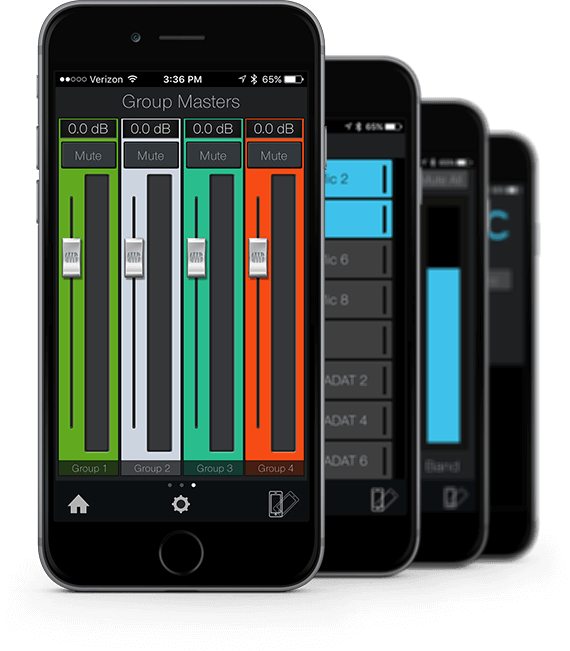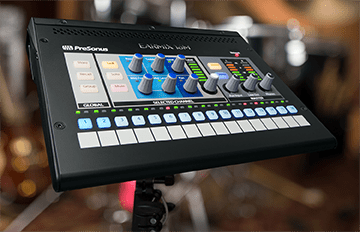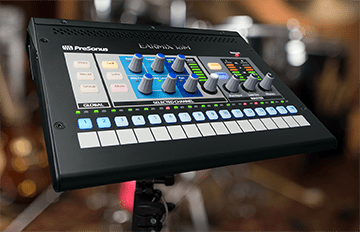How do we budget for personal monitor mixing systems?
Most mixers have some ability to send at least a universal monitor mix to the stage. This is typically done with auxiliary buses (aux buses for short). Let’s say a mixer has one aux bus. On a mixer like this, each channel would have an aux send level control. This control adjusts the volume of each channel in the aux bus mix. You build your monitor mix by setting the individual aux-send levels for any channels you want in that mix. The aux mix output can then be connected to a stage monitor. In this way, your musicians can listen to a monitor mix that can be controlled separately from the main mix going out to the congregation.
If you’re thinking an aux send sounds a lot like a channel fader, you’re way ahead of the game. Just as each channel fader allows you to create a mix for the main output, each aux send allows you to create a mix for the corresponding aux bus output. (Aux sends can also be used for other things like routing controlled amounts of signals to outboard effects.)
If you’re using aux buses exclusively for monitors, the number of aux buses you have determines the number of discrete monitor mixes you can create. Most affordable mixers have one or two. Two aux buses provide two separate mixes; six aux buses provide six separate mixes; etc. Note that aux buses and their sends are typically mono, so a performer who needs a stereo monitor mix (such as a keyboardist using stereo in-ear monitors) will need two aux buses: one for the left side of the mix, one for right. Keep this in mind when determining how many aux buses you need.
Good news: StudioLive mixers have lots of aux buses for creating discrete monitor mixes: 2 to 32, depending on model. Every aux bus on StudioLive mixers feature feedback-busting, frequency-balancing, dynamic-processing goodness thanks to the Fat Channel. This allows you to create high-quality, individual mixes for your performers without spending additional funds beyond the cost of the StudioLive and monitors.
 Even better, aux mixes on StudioLive Series III digital mixers can be wirelessly controlled from wireless mobile devices using free software. With free PreSonus QMix®-UC software for iPhone®, iPod® touch, and Android™ devices, up to 16 worship musicians—and for that matter, the choir director and pastor—can simultaneously control their own StudioLive monitor mixes.
Even better, aux mixes on StudioLive Series III digital mixers can be wirelessly controlled from wireless mobile devices using free software. With free PreSonus QMix®-UC software for iPhone®, iPod® touch, and Android™ devices, up to 16 worship musicians—and for that matter, the choir director and pastor—can simultaneously control their own StudioLive monitor mixes.
QMix-UC makes creating monitor mixes easy with the Wheel of Me view. This lets you select multiple “Me” channels and turn them all up in your monitor at the same time while controlling the relative balance between “Me” and the rest of the band.
More advanced users can have complete control of the aux-mix send level and panning (for linked auxes) for each channel from the Aux view. These users can also create four custom groups. This allows them to divide complicated mixes into something more manageable.
Using the StudioLive security features, you can let each musician create a personal monitor mix—or restrict them to the Wheel of Me while you create their mix for them.
Good news: Because QMix-UC remote controls the aux mixes on the StudioLive mixer itself, an experienced mixer volunteer running the main system can assist less-experienced praise band members with monitor mix issues, without leaving the front-of-house position. Because this mix is coming directly from the mixer and not from a personal monitoring system, the front-of-house engineer can even listen in on any monitor mix to better assist in creating the best mix possible.
 For praise team members that are more comfortable with a hardware mixer, rather than a touchscreen, there are many hardware personal monitor mix systems that can be integrated into either a digital mixer or added to an existing analog system. A personal monitor solution like this is compromised of three essential components:
For praise team members that are more comfortable with a hardware mixer, rather than a touchscreen, there are many hardware personal monitor mix systems that can be integrated into either a digital mixer or added to an existing analog system. A personal monitor solution like this is compromised of three essential components:
- The personal monitor mixer that the user controls
- The switch that routes audio to each personal monitor mixer
- The hub that connects to the main front-of-house mixer
Until recently, personal monitoring solutions have been very expensive and very low-frills. PreSonus EarMix systems changed all that by providing a 16-channel personal monitor mixer with 3-band EQ and limiting on every channel. Since the hub for EarMix personal monitor mixers is a StudioLive Series III rack mixer, EarMix 16M monitor mixers are provided with Noise Gate, Compression, and EQ on every channel, plus reverb and the busing necessary to simplify large mixes.
Because of the advanced audio networking built into StudioLive Series III digital mixers, EarMix 16M personal monitor mixers can be connected directly to a StudioLive Series III console mixer. All audio can be routed directly from the touch display on the StudioLive Series III console mixer, simplifying set-up and integration.







